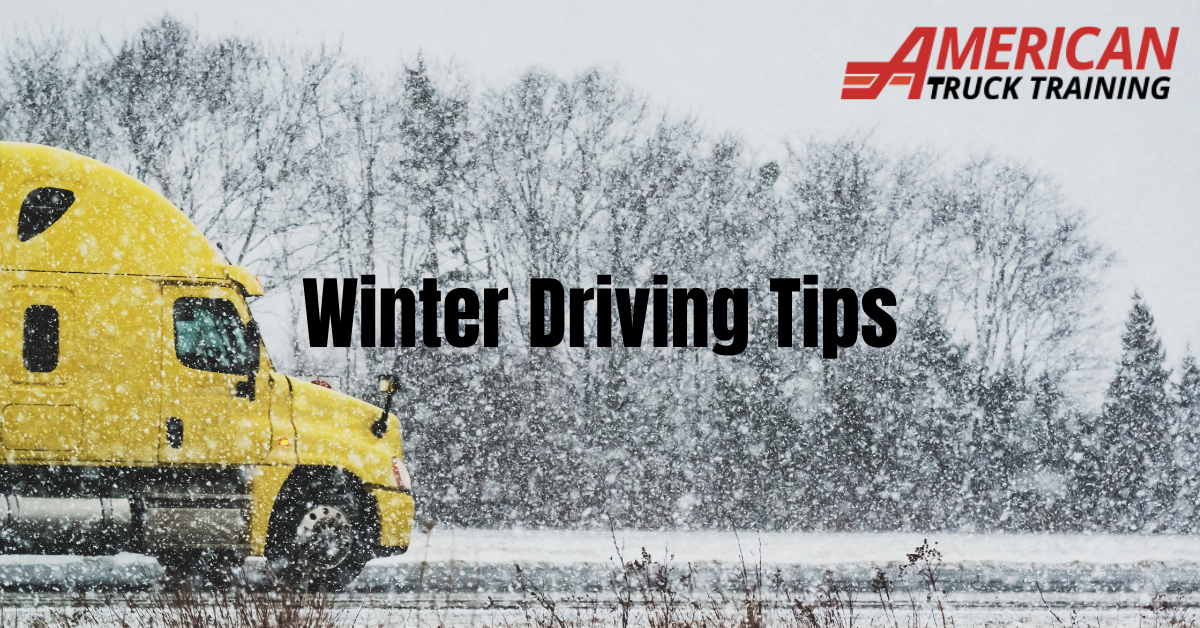
It’s wintertime in Oklahoma and at American Truck Training we want to provide you with some helpful tips for safe winter driving. With the change in the weather, it is important to remember that the roads will be icy and dangerous. According to the National Highway Traffic Safety Administration (NHTSA), in 2019, there were 440 fatal crashes, and an estimated 33,000 injury crashes that occurred in wintry conditions.
Get Started
Trucking can be risky in the winter, and it takes knowledge and preparation to get to your destination safely. Here are some winter driving guidelines to keep you safe this winter.
Be prepared
It’s critical to double-check your gear before setting out on your adventure, especially during the severe winter months. Make sure you’re prepared and have the following items on hand:
- Shovel and a bag of sand or salt
- Tire chains
- Jumper cables
- Windshield washer fluid and ice scraper
- Warm blanket and an extra layer of clothes
- Food and water
- Flashlight
- High-visibility vest or jacket
Make sure your rig is also prepared and ready to go before you head out. Double-check that your defroster and heater are operating properly. Check your lights, wipers, and mirrors (especially your brake lights), keep your gas tank at least half full and clear off and prepare your truck as needed. A clean truck is a safe truck.
Drive carefully
Sudden movements might result in a loss of control; strong acceleration and braking reduce traction. Maintain a constant speed and use the brakes sparingly. Maintain a comfortable braking space between you and the car in front of you in ice conditions. Since approximately 17% of all automobile collisions occur during the winter months according to the NHTSA, all truck drivers should:
Slow down
Most collisions occur because of drivers traveling too quickly. It is especially important for new truck drivers to take your time and get used to how your rig handles. Remember that controlling and stopping on a snow-covered road is considerably more difficult! Increase your following distance on the road to give yourself ample time to stop for vehicles ahead of you.
Also keep in mind that speed limits are designed for dry roads, not roads with dangerous precipitation. Going too fast can potentially result in hydroplaning. Keep an eye on your speed to avoid winter accidents.
Allow extra space
In inclement weather or hazardous road conditions, increase your distance to give yourself more time to respond to the vehicles in front of you. According to the FCMSA “, a fully loaded truck traveling in good road conditions at highway speeds needs a distance of nearly two football fields to stop.” Therefore, allow 10 times the standard stopping distance in bad road conditions.
As a general rule, always be attentive to your surroundings, especially on exit ramps, bridges, and other similar structures.
Drive smoothly
Your actions need to be controlled and deliberate while maintaining a regular, steady speed. Hard acceleration, hard braking, and sharp curves all decrease traction. Steer gently and remember that inertia will be a factor.
Be mindful of hazards
Trucking in the winter can be dangerous in and of itself, but there are two specific dangers to be aware of: While many people connect dangerous weather with snow and ice, fog, rain, and sun glare can all have a significant impact on driver safety.
Black ice
Keep an eye out for signs of black ice on the roads when temperatures are close to freezing. Black ice appears as a thin layer of transparent ice that makes the road appear slightly damp. In general, be cautious about black ice if you see a build-up of ice on your truck’s mirror arms, antennae, the upper corners of the glass, or if the spray from the tires on the vehicles in front of you stops.
Fog
Use your lights and slow down if there is a lot of fog and vision is limited. Even if automobiles are traveling at a faster rate than you. Keep your windshields as clear as possible.
Heavy rain
It’s best to slow down if you’re having trouble seeing the road ahead due to heavy rain. Maintain a safe space between you and the vehicles ahead of you and be wary of hydroplaning.
Bridges
Bridges, highway overpasses, and other elevated surfaces ice more quickly than normal roads. It’s also possible that they may not be salted yet. Approach bridges with caution to prevent spinning out of control on black ice.
Know when to stop
When it comes to pulling over for road conditions, there is a good time and a bad time. If winter conditions become so dangerous that driving is no longer viable, find a place to stop. Avoid stopping on the shoulder, if at all possible, as this will increase your chances of being hit by other drivers. Instead, find a gas station or any other 24-hour business and wait until visibility improves.
Do not stop if there is zero visibility (i.e., you can’t see beyond your hood). Another vehicle will hit you. Continue to creep along until you can safely get your vehicle off the road.
Although the weather is out of your control, you must be prepared for winter and prevent hazards or potential accidents.
If you’re looking for a new career as a Class A CDL truck driver, get professional truck driver training at American Truck Training. Contact us today for details.